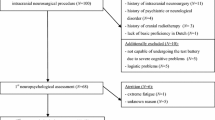Abstract
The recovery of patients after general anesthesia is usually estimated by using clinical scores. Since there is a lack of objective methods for assessing psychomotor recovery, the aim of this study was to evaluate three psychological tests for this purpose. Patients, scheduled for ambulatory gynecological surgery, underwent 3 standard psychological tests before (T1), 15 min after the surgery (T2) and on discharge from the recovery room (T3). The tests used were Wechsler memory scale (test 1, working memory capacity), d2—test (test 2, concentration endurance) and computer-based 4-choice-reaction time (4CRT, test 3, reaction time) as well as Postanesthesia Discharge Scoring System (PADSS). The same test battery was used in healthy female volunteers, all test results were compared at the different time points. In 109 patients, working memory capacity and concentration (tests 1 and 2) decreased, the reaction time (test 3) was prolonged at T2 in comparison with T1 and T3 (P < 0.01). PADSS increased from 8 (T2) to 10 (T3) (medians, P < 0.001). Fifty-seven healthy volunteers demonstrated a practice effect in all 3 tests through the course of the study (P <0.01). 4CRT test had shortest duration and enabled computerized data processing. All three tests objectively assess the recovery of psychomotor function in patients after general anesthesia, the computer-based 4CRT seems to be the most convenient for the clinical routine.





Similar content being viewed by others
References
Aldrete JA, Kroulik D. A postanesthetic recovery score. Anesth Analg. 1970;49:924–34.
Chung F, Chan VW, Ong D. A post-anesthetic discharge scoring system for home readiness after ambulatory surgery. J Clin Anesth. 1995;7:500–6.
Marshall SI, Chung F. Discharge criteria and complications after ambulatory surgery. Anesth Analg. 1999;88:508–17.
Chung F, Assmann N. Car accidents after ambulatory surgery in patients without an escort. Anesth Analg. 2008;106:817–20.
Bowyer A, Jakobsson J, Ljungqvist O, Royse C. A review of scope and measurement of postoperative quality of recovery. Anaesthesia. 2014;69:1266–78.
Drummond GB. The assessment of postoperative mental function. Br J Anaesth. 1975;47:130–42.
Hendry JGB, Norris W, Nisbet HIA. Objective measurement of sedation III: the reaction timer. Br J Anaesth. 1963;35:716–8.
Spinweber CL, Johnson LC. Effects of triazolam (0.5 mg) on sleep, performance, memory, and arousal threshold. Psychopharmacology. 1982;76:5–12.
Huron C, Giersch A, Danion JM. Lorazepam, sedation, and conscious recollection: a dose-response study with healthy volunteers. Int Clin Psychopharmacol. 2002;17:19–26.
De Candia MP, Di Sciascio G, Durbano F, et al. Effects of treatment with etizolam 0.5 mg BID on cognitive performance: a 3-week, multicenter, randomized, double-blind, placebo-controlled, two-treatment, three-period, non- inferiority crossover study in patients with anxiety disorder. Clin Ther. 2009;31:2851–9.
Otawara Y, Ogasawara K, Kubo Y, Kashimura H, Ogawa A, Yamadate K. Comparison of postoperative cognitive function in patients undergoing surgery for ruptured and unruptured intracranial aneurysm. Surg Neurol. 2009;72:592–5.
Prager G, Kalaschek A, Kaczirek K, et al. Parathyroidectomy improves concentration and retentiveness in patients with primary hyperparathyroidism. Surgery. 2002;132:930–5.
Tewes U. Hamburg-Wechsler-Intelligenztest für Erwachsene. Revision. Handbuch und Testanweisung. Bern: Hans Huber; 1991.
Brickenkamp R. Test d2 Aufmerksamkeits-Belastungs-Test. Göttingen: Hogrefe Verlag; 2000.
Millar K, Asbury AJ, Bowman AW, et al. A randomised placebo-controlled trial of the effects of midazolam premedication on children’s postoperative cognition. Anesthesia. 2007;62:923–30.
Grant SA, Murdoch J, Millar K, Kenny GNC. Blood propofol concentration and psychomotor effects on driving skills. Br J Anaesth. 2000;85:396–400.
Deary IJ, Der G. Reaction time, age and cognitive ability: longitudinal findings from age 16 to 63 years in representative population samples. Aging Neuropsychol Cogn. 2005;12:187–215.
Dale MT, Naik R, Williams JP, Lloyd AJ, Thompson JP. Impairment of sustained attention after major gynaecological surgery. Eur J Anaesth. 2005;22:843–7.
Versavel M, van Laack D, Evertz C, Unger S, Meier F, Kuhlmann J. Test-retest reliability and influence of practice effects on performance in a multi-user computerized psychometric test system for use in clinical pharmacological studies. Arzneimittelforschung. 1997;47:781–6.
Reimers S, Maylor EA. Gender effects on reaction time variability and trial-to-trial performance: reply to Deary and Der (2005). Neuropsychol Dev Cogn B Aging Neuropsychol Cogn. 2006;13:479–89.
http://lehmannro.github.io/4crt. Accessed 13 Jan 2019.
Dykiert D, Der G, Starr JM, Deary IJ. Sex differences in reaction time mean and intraindividual variability across the life span. Dev Psychol. 2012;48:1262–76.
Der G, Deary IJ. Age and sex differences in reaction time in adulthood: results from the United Kingdom Health and Lifestyle Survey. Psychol Aging. 2006;21:62–73.
Eysenck MW, Derakshan N, Santos R, Calvo MG. Anxiety and cognitive performance: attentional control theory. Emotion. 2007;7:336–53.
Hickey S, Asbury AJ, Millar K. Psychomotor recovery after outpatient anesthesia: individual impairment may be masked by group analysis. Br J Anaesth. 1991;66:345–52.
Acknowledgements
The authors thank Maria Gagarine for re-checking of the manuscript for mistakes, the patients and the volunteers who took part in this investigation as well as the anesthetic nurses who helped to conduct the investigation.
Funding
Departmental funding only.
Author information
Authors and Affiliations
Corresponding author
Ethics declarations
Conflict of interest
The authors declare that they have no conflict of interest.
Additional information
Publisher's Note
Springer Nature remains neutral with regard to jurisdictional claims in published maps and institutional affiliations.
Taras I. Usichenko and Danika Städing have contributed equally to this work.
Electronic supplementary material
Below is the link to the electronic supplementary material.
10877_2019_355_MOESM1_ESM.pptx
Supplementary material 1 (PPTX 1295 kb) Supplementary figure. Laptop with the DOS-based software with four-choice-reaction-time (4CRT) test. One out of 4 possible digits is displayed on the screen of the laptop; the response unit connected to the laptop with the buttons 1-4 is seen on the right side.
Appendices
Appendix 1

Appendix 2

Rights and permissions
About this article
Cite this article
Usichenko, T.I., Städing, D., Boesche, M. et al. Computerized 4-choice reaction time test for the measurement of psychomotor recovery after general anesthesia. J Clin Monit Comput 34, 833–841 (2020). https://doi.org/10.1007/s10877-019-00355-3
Received:
Accepted:
Published:
Issue Date:
DOI: https://doi.org/10.1007/s10877-019-00355-3




